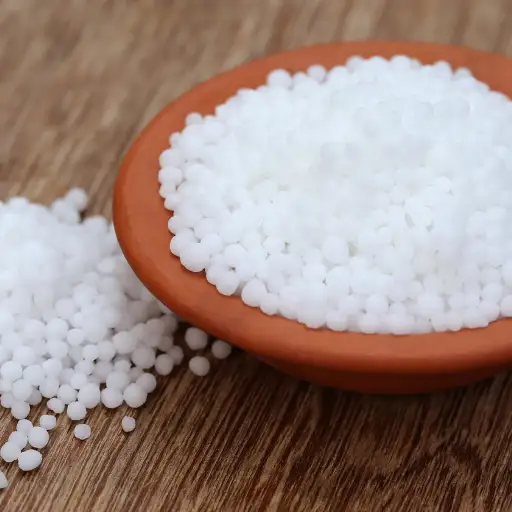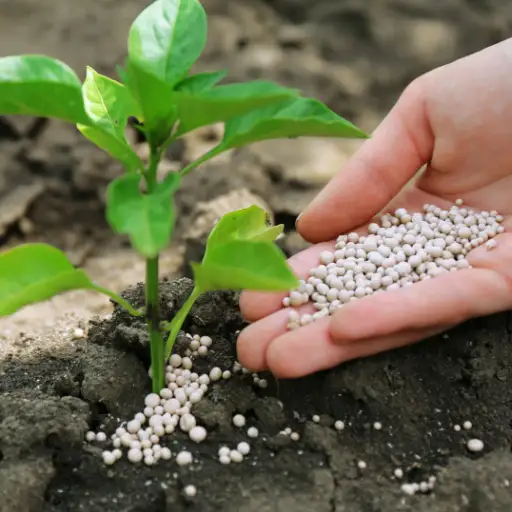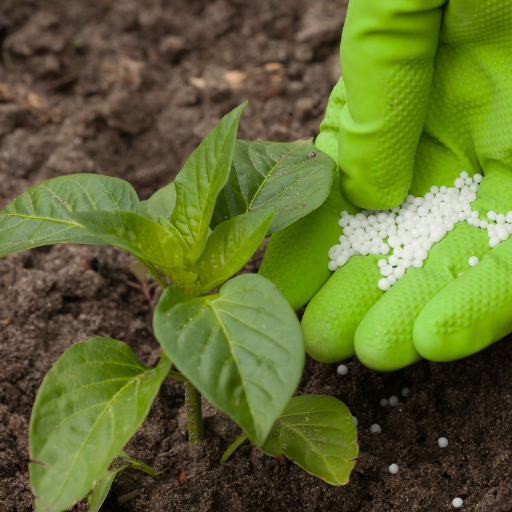CAN fertilizer, a widely used and highly effective calcium ammonium nitrate fertilizer, is essential to plants’ growth and development by providing them with the necessary nutrients. It combines the advantages of both calcium and ammonium nitrate which make it a good option for many crops and soil types. This article will delve into what Calcium Ammonium Nitrate Fertilizer is, its main benefits as well as how it can contribute to improved plant health and productivity. Whether you have been gardening for long or just starting out, knowing about CAN fertilizer’s role in plant nutrition could go a long way in helping you achieve beautiful healthy gardens with bumper yields.
What are the Key Properties of Calcium Ammonium Nitrate Fertilizer?

CAN or Calcium Ammonium Nitrate is a fertilizer that is well known for its high solubility and quick-release properties so it can provide nutrients to plants immediately. It usually carries nitrogen (about 26-28% of the total weight) in ammonium (NH4+) and nitrate (NO3-) forms, making sure that the supply of nitrogen is balanced. The calcium content about 8-10% improves soil structure and builds up plant cell wall strength leading to healthier and more tolerant plants. Compared with other N fertilizers, CAN has less volatility and leaching problems, making it a good choice for various crops and soils. Its granular form allows it to be spread easily over wide areas.
What Chemical Compounds Make Up Calcium Ammonium Nitrate?
Calcium Ammonium Nitrate (CAN) majorly comprises ammonium nitrate (NH4NO3) and calcium carbonate (CaCO3). Within this compound, the ammonium nitrate component supplies both the ammonium ions NH4+ and nitrates NO3-, while the calcium carbonate component provides the ions Ca2+ necessary for improving soil structure and enhancing plant cell wall thickness. A combination of these elements ensures a balanced supply of essential nutrients needed by plants, hence promoting their growth and soil health.
How Does Calcium Nitrate Differ From Other Fertilizers?
The main difference between calcium nitrate fertilizers from others lies in their chemical composition and particular benefits they confer. Most other nitrogen-based fertilizers contain either urea or ammonium while calcium nitrate differentiates itself by providing nitrogen in an easily available form i.e., nitric acid, which is quickly absorbed by plants. In addition, it contains substantial amounts of calcium element that secondary nutrient crucial for hardening tissues; enhancing fruit quality; overall plant vigor improvement among other numerous reasons. This dual-nutrient composition improves nutrient uptake and minimizes the risks associated with imbalances and deficiencies. Also, calcium nitrate is highly soluble, thus suitable for use in fertigation systems and foliar applications to ensure uniform spread of nutrients and efficient absorption.
What Nutrients Does Calcium Ammonium Nitrate Provide to Plants?
The primary nutrients available in CAN or Calcium Ammonium Nitrate include nitrogen and calcium that plants need. The nitrogen usually comes in forms of ammonium (NH4+) as well as nitrate (NO3-) which are vital during growth of plants, synthesis of proteins and formation of chlorophylls. The N content is generally 27-28% which comprises quick acting NO3-Nitrogen (14-15%) and slow acting NH4 – Nitrogen (13-14%). Normally, calcium ranges from 8 to 10%. It helps in strengthening cell walls making them healthier hence more resistant against pests and diseases. With well balanced nutrient profile such as this one, there will be fast development for the plant civilization and a healthy soil together.
How Does Calcium Ammonium Nitrate Fertilizer Affect Soil?

Soil application of CAN fertilizes and promotes the health of soil by providing crucial nutrients, enhancing soil structure as well as encouraging beneficial microbial activities. Both ammonium and nitrate forms of nitrogen provide plants with a continuous supply of nitrogen over time maintaining a steady nutritional balance. Moreover, the presence of calcium in CAN ameliorates soil structure by reducing acidity that improves root penetration and water infiltration. It also enhances cation exchange capacity of the soil that helps it to retain and adequately supply nutrients to plant species. In addition,CAN prevents soil compaction and promotes better movement of air through it thus assisting in healthier growth and more vigorous plants.
Soil pH impact
CAN has a neutral to slightly acidifying effect on soil pH. The ammonium part in CAN temporarily lowers the soil pH due to its conversion to nitrates during nitrification. Yet, calcium levels counterbalance this acidification by neutralizing soil acidity.CAN is, therefore, an appropriate alternative for maintaining uniform pH in soils since it balances these acidifying effects with other neutralizing effects, such as nutrient availability, leading to good growth conditions among plants.
Calcium Nitrate’s role in Soil Fertility
Because of its diverse composition and benefits aimed at improving fertility, calcium nitrate plays an important role in increasing fertility levels in soils. This fertilizer offers both immediately available calcium ions (Ca++) and nitrate-nitrogen(NO3^-) which are necessary for vigorous plant growth and development.Calcium flocculates clay particles resulting into improved aeration making better root growth possible.Nitrate-nitrogen becomes easily absorbed and utilized by many plants, enhancing photosynthesis rates and general plant health.
- Nutrient Composition:
- Typically contains 19% soluble calcium (Ca).
- Usually comprises around 15.5% nitrate nitrogen (N).
- Soil Structure & Aeration:
- This helps aggregate soils particles towards improved structure but reduces compactness.
- Proper root development is achieved by firm soil aeration.
- pH Stability:
- Calcium nitrate can be applied to mitigate soil acidity and achieve a more neutral pH, enhancing nutrient availability.
- Cation Exchange Capacity (CEC):
- Calcium helps increase CEC making the soil better at retaining and supplying nutrients.
This makes calcium nitrate an effective option for enriching soil fertility so that plants receive the required essential subsidies for optimum growth and yield.
How Does This Fertilizer Improve Soil Quality?
The role of Calcium Nitrate in enhancing soil quality is manifold. Firstly, it provides plant-available forms of vital nutrients such as nitrogen and calcium, which improves nutrient uptake, resulting in increased crop yields. The presence of calcium helps improve soil structure by flocculating clay particles, reducing compaction, and enhancing aeration, hence encouraging healthier root systems.
Technical Parameters:
- 19% soluble calcium improves soil structure and root growth by aggregating soil particles (Ca).
- 15.5% nitrate nitrogen enhances photosynthesis and overall plant health due to its high availability and rapid plant uptake (N).
Lastly,calcium nitrate reduces acidity in soils, stabilizing pH and enhancing optimal conditions for nutrient availability. Improved Cation Exchange Capacity(CEC) through the addition of Ca means that more important elements are kept within this space.These technical benefits together contribute to enhanced soil fertility, enabling stronger plant growth and leading to more gains from agriculture.
What are the Best Practices for Applying Calcium Ammonium Nitrate Fertilizer?

To achieve the best results when applying Calcium Ammonium Nitrate (CAN) fertilizer, follow these key practices:
- Timing of Application: Apply CAN during the growing season, ideally at planting and when plants exhibit rapid growth phases. Split applications can ensure steady nutrient availability.
- Application Method: Evenly distribute granules over the soil surface, avoiding direct contact with plant foliage to prevent burning. Incorporate the fertilizer into the soil during pre-planting preparations for precise nutrient delivery.
- Rate of Application: Follow specific crop nutrient requirements and soil test results to determine the appropriate fertilizer rate. Over-application can lead to nutrient runoff and environmental harm, while under-application may result in suboptimal plant growth.
- Watering: After application, irrigate the area to help dissolve the fertilizer and wash nutrients into the root zone, ensuring effective nutrient uptake by plants.
- Safety Precautions: Always carefully handle CAN fertilizer, wearing protective gear as necessary. Store in a cool, dry place to avoid moisture-related caking and maintain product efficacy.
How to mix calcium ammonium nitrate with other nutrients?
Mixing Calcium Ammonium Nitrate (CAN) with other nutrients requires careful consideration to ensure compatibility and effective nutrient uptake. Here are some guidelines:
- Compatibility Check: Before mixing CAN with other fertilizers, check for compatibility. Some nutrients may react with CAN, leading to the formation of insoluble compounds or reduced effectiveness. Use a compatibility chart or perform a jar test: combine small amounts of CAN and the other nutrient in water to observe any adverse reactions.
- Sequential Mixing: If compatibility is confirmed, mix CAN with other soluble fertilizers sequentially. Start by dissolving CAN in water, then add the other nutrients one at a time. This prevents nutrient precipitation and ensures proper solubility.
- Optimal Ratios: Follow recommended ratios for mixing based on crop requirements and soil conditions. For example, combining CAN with potassium (K) and phosphorus (P) in appropriate ratios can enhance overall plant nutrition. A typical ratio might be CAN:NPK ratio of 5:5:5, but always adjust based on specific crop and soil needs.
- Technical Parameters:
- pH Levels: Maintain soil pH between 6.0 and 7.0 to ensure maximum nutrient availability and prevent nutrient lockout.
- Mixing Water Quality: Use clean, non-saline water for mixing to avoid introducing contaminants that could affect nutrient solubility.
- Application Concentration: Prepare nutrient solutions with a total dissolved solids (TDS) concentration suitable for the crop. For example, a TDS of 800-1200 ppm is usually effective for most vegetables.
- Application Timing: For maximum benefit, apply mixed nutrient solutions during key growth stages. For instance, split applications during the vegetative and blooming stages can optimize nutrient availability and plant uptake.
Following these best practices, you can effectively mix and apply Calcium Ammonium Nitrate with other nutrients, promoting healthy plant growth and higher yields. Consider specific crop requirements and regularly conduct soil tests to fine-tune nutrient management practices.
How Should Calcium Ammonium Nitrate Be Mixed Into Soil?
To mix Calcium Ammonium Nitrate (CAN) into the soil effectively, follow these steps:
- Soil Preparation: Till the soil to a fine texture before application to ensure uniform distribution and proper fertilizer incorporation.
- Application Rate: Determine the appropriate application rate based on soil tests and crop needs, typically ranging from 200 to 400 pounds per acre.
- Even Distribution: Broadcast the CAN evenly over the soil surface using a spreader or apply it in bands or rows for precision.
- Incorporation Depth: Mix the CAN into the top 2-4 inches of soil to ensure it reaches the root zone, promoting effective nutrient uptake.
- Watering: After application, irrigate the soil to dissolve the granules and activate the nitrogen and calcium, aiding in faster nutrient availability to the plants.
What are the Recommended Application Rates for Different Crops?
- Corn:
- Application Rate: 250-300 pounds per acre.
- Details: Corn has high nitrogen demands, particularly during the periods of rapid growth and tasseling. Applying Calcium Ammonium Nitrate can support ear development and overall yield.
- Wheat:
- Application Rate: 150-250 pounds per acre.
- Details: Wheat benefits from a steady nitrogen supply during tillering and stem elongation stages. Adequate nitrogen can improve grain protein content and overall production.
- Tomatoes:
- Application Rate: 200-300 pounds per acre.
- Details: A balanced nutrient supply is crucial for tomatoes. Applying CAN provides essential calcium, reducing the risk of blossom-end rot while supporting vigorous growth and fruit development.
- Potatoes:
- Application Rate: 300-400 pounds per acre.
- Details: Potatoes require substantial nitrogen inputs for tuber formation. CAN provides both nitrogen and calcium to aid in maintaining tuber quality and yield.
- Lettuce:
- Application Rate: 150-200 pounds per acre.
- Details: Lettuce, being a leafy green, requires consistent nitrogen to promote leaf expansion and maintain a fresh, vibrant appearance. Calcium from CAN helps in reducing tip burn.
- Cotton:
- Application Rate: 200-350 pounds per acre.
- Details: Cotton heavily relies on nitrogen during its growth. Proper application of CAN can enhance fiber quality and boll development while providing necessary calcium.
- Sorghum:
- Application Rate: 120-180 pounds per acre.
- Details: Sorghum, adapted to lower fertility soils, benefits from moderate nitrogen inputs through CAN to boost stalk strength and grain production, especially under drought conditions.
What Are the Benefits of Using Calcium Ammonium Nitrate as a Nitrogen Source?

The use of Calcium Ammonium Nitrate (CAN) as a source of nitrogen is common among farmers seeking to increase crop yields. First, it provides both calcium and ammonium nitrogen in balanced quantities which in turn reduces volatilization of nitrogen and increases its plant efficiency. This results in sustained growth especially at critical developmental stages. CAN’s calcium component also enhances soil structure, allowing more robust root systems that produce stronger crops. CAN has a neutral pH therefore cannot cause soil acidity like other forms of nitrogen fertilizers, making it possible to use on different kinds of soils. Hence CAN addresses immediate nutrient requirements as well supports long-term soil health thereby enhancing overall agricultural productivity.
Comparing with Other Nitrogen Fertilizers
Calcium Ammonium Nitrate (CAN) stands out compared to other common nitrogen fertilizers such as Urea, Ammonium Nitrate, and Ammonium Sulfate.
- Urea:
- Nitrogen Content: 46% N (highest among common fertilizers).
- Volatilization: Higher risk, especially when surface-applied without incorporation into the soil.
- Soil pH Effect: Potentially acidifying over time due to hydrolysis process.
- Efficiency: Needs timely application and proper management to avoid nitrogen losses.
- Ammonium Nitrate:
- Nitrogen Content: 34% N.
- Volatilization: Lower risk compared to Urea; provides both nitrate and ammonium forms.
- Soil pH Effect: Slightly acidifying.
- Efficiency: Effective for quick uptake by plants; less prone to leaching.
- Ammonium Sulfate:
- Nitrogen Content: 21% N.
- Sulfur Content: 24% S (additional nutrient for plants).
- Soil pH Effect: Strongly acidifying.
- Efficiency: Beneficial in sulfur-deficient soils; enhances protein synthesis and chlorophyll production.
- Calcium Ammonium Nitrate (CAN):
- Nitrogen Content: Roughly 27% N.
- Volatilization: Minimal due to its stability and balanced nitrogen form.
- Soil pH Effect: Neutral to slightly basic, reducing soil acidification risk.
- Efficiency: Excellent for maintaining soil structure, providing both immediate and sustained nutrient release, minimizing losses, and improving root development.
In summary, while Urea offers the highest nitrogen content, its volatilization risk and management needs often complicate its use. Ammonium Nitrate and Ammonium Sulfate each provide significant benefits but come with their own limitations concerning soil pH and additional nutrient requirements. CAN, with its balanced composition and neutral pH, provides a reliable and efficient nitrogen source while enhancing soil health.
Enhancing Crop Yields and Quality
In order to enhance crop yields and quality, it is necessary to establish a comprehensive approach comprising appropriate fertilizer use, soil health management and efficient irrigation processes. Balanced application of fertilizers is paramount with emphasis on delivering the correct nutrients at the right time especially nitrogen, phosphorus and potassium. It also good to have a regular soil-testing program for accurate nutrient management that will ensure prompt intervention in cases of shortage. Also introducing organic matter like compost or cover crops can improve soil structure making it more fertile, which in turn enhances water retention and root growth. Drip irrigation or scheduled watering can keep soil moisture levels fairly constant thus reducing plant stress while promoting uniform development. Integrated pest control (IPC) methods are another way by which crops can be saved from pests and diseases with less chemicals being used. Putting together these measures on the farm will result in sustainable high yields and better product quality.
What Are the Considerations for Packaging and Storage?

Factors like moisture control, temperature stability and proper labelling need to be addressed when thinking about packaging and storage for fertilizers. Fertilizers must be stored in an environment that is dry to avoid aggregated masses and lose their quality because they were exposed to moisture. Temperature is also important since extreme temperatures would change the chemical properties of the fertilisers making them less effective. These problems can be avoided by right packing modes including use of moisture proof bags such as containers made from polyethylene materials among other options. Besides, each package must indicate the contents, handling instructions and safety precautions.
The quality of fertilizers can also deteriorate when kept in a well-ventilated area that does not have direct sunlight or heat sources. Adhering to these practices reduces the risk of contamination, extends shelf life, and ensures that the fertilizers remain effective for their intended use.
How Can We Store Calcium Ammonium Nitrate Safely?
Calcium Ammonium Nitrate (CAN) should be stored in cool, dry, ventilated places free from any source of heat, spark, or open flame. This type of fertilizer absorbs water from the air and becomes damp, leading to clumps and reduced efficiency during its application process. For this reason, it should be packed using moisture-resistant materials such as sealed plastic bags or containers. This will prevent possible damage due to temperature rise above 30°C (86°F).
Additionally, CAN needs high care in terms of preventing its contact with organic substances oils among others which pose risks for burning processes taking place thereupon soiling it up with impurities. It is vital for cans always labeled according handling instructions plus safety precautions in order to ensure safe usage. The packaging must also have good storing practice whereby regular inspections are done on them so as to check even signs of moisture or if any damages happened on them which may affect their contents thus lowering their effectiveness towards plants purposes like growing crops .These guidelines help maintain the quality and efficacy of Calcium Ammonium Nitrate.
Packaging Options Commonly Used
Common packaging options for fertilizers include plastic bags which are durable and moisture-resistant, thus making them suitable for hygroscopic materials like CAN. Other popular options include woven polypropylene bags, which offer strength and flexibility, often lined with polyethylene to provide extra moisture protection. Also, large quantities can be stored in bulk storage containers such as intermediate bulk containers (IBCs) or big bags, which are easy to transport and store. In summary, all these types of packaging help maintain the quality and effectiveness of fertilizers by providing enough protection against moisture and contamination.
What Precautions Should Be Taken?
When handling or storing Calcium Ammonium Nitrate (CAN), there are several key precautions that must be taken into account. The use of proper personal protective equipment (PPE), such as gloves, safety goggles, and dust masks is essential while using this chemical so that it cannot affect us directly by getting soaked into our skin or eyes or even inhale it when particles are being released through air during its application. Storage areas should be kept dry as well as cool hence leading to good ventilation hence reducing the rate at which moisture can get sucked up by fertilizer. Do not place CAN near incompatible substances, including fuel and organic matter-reducing agents, due to possible contamination that may lead to a dangerous reaction taking place later on.
- Temperature: Store below 30°C (86°F)
- Humidity: Keep product dry and use moisture-resistant packaging
- Ventilation: Ensure storage areas are well-ventilated
To sustain the product’s integrity, occasional checks on warehouse and packing spaces for signs of destruction or wetness, should be done. Moreover, there should be clear and visible signboards indicating the presence of dangerous materials and the specific safety measures required. Proper marking of containers with handling instructions and safety tips will enhance safe usage as well as compliance with regulatory requirements. These guidelines ensure that CAN-related risks are effectively managed.
Are There Any Risks or Drawbacks?

Yes, there are risks and drawbacks associated with CAN. The major concern is the explosion accident if wrongly or inadequately stored in a surrounding area that has heat sources or impurities, including combustibles. It can cause irritation of the respiratory tract, eyes, and skin; it is harmful when swallowed; besides all that. There may be nitrate leaching into water supplies leading to eutrophication as well as water pollution. Long-term exposure to high levels of nitrates can also lead to health problems such as methemoglobinemia or “blue baby syndrome” in children. Therefore, it’s necessary to take proper precautions and adhere to safety guidelines.
The potential impacts on the environment
Calcium ammonium nitrate (CAN) presents significant dangers when released into the environment because of its high nitrate content. One primary environmental impact is nutrient pollution caused by the leaching of nitrates into water bodies, resulting in excessive growth of algae and aquatic plants. The process called eutrophication removes oxygen from the water hence causing death zones for fish and other aquatic animals living there. In addition, mobility in soil media renders CAN a source of groundwater contamination thereby posing risks to drinking water supply and possibly leading to unsafe concentrations of nitrates for human well-being. Furthermore, these environmental challenges could be intensified due to wrong handling methods applied during fertilization processes thus stressing on needful management practices.
Avoiding overuse and toxicity
To mitigate risks arising from overuse and toxicity associated with Calcium Ammonium Nitrate (CAN), best management practices should be adopted. Overdose can be avoided through right application rates based on crop requirements and soil tests recommendations. As per the recommendations given by agronomy experts via agriculture.gov, extension.org, and fao.org, technical parameters for an application often suggest a dosage range of 100-200 kg/ha according to soil nitrate levels as it varies with specific crop needs.
In addition, splitting the total amount of fertilizer into smaller amounts throughout the growing season, also known as split applications, can improve nutrient use efficiency and reduce leaching. Buffered strips or vegetative barriers near water bodies could contribute to minimizing nutrient runoff. Controlled-release formulations of CAN should be promoted to reduce nitrate leaching further since it allows nutrients to be released in accordance with plant uptake. It is important to adhere to these practices for safe CAN fertilizers and environmental sustainability.
Reference sources
- Medium
- Source Link: Benefits of Calcium Ammonium Nitrate Fertilizer
- Summary: This article discusses the key advantages of Calcium Ammonium Nitrate Fertilizer, emphasizing its role in improving nutrient uptake and soil health.
- Gardening Know How
- Source Link: What Does Calcium Nitrate Do For Plants
- Summary: This resource explains the benefits of calcium nitrate, including its impact on plant growth and its ability to prevent calcium deficiency disorders in plants.
- Sinooan
- Source Link: The advantages and uses of calcium ammonium nitrate fertilizer
- Summary: The article outlines various benefits of calcium ammonium nitrate, such as improving soil structure, enhancing plant health, and preventing soil caking.
Frequently Asked Questions (FAQs)
Q: What is Calcium Ammonium Nitrate Fertilizer?
A: Calcium Ammonium Nitrate (CAN) Fertilizer is an inorganic fertilizer that combines ammonium nitrogen and nitrate nitrogen, providing essential nutrients to plants. It typically contains a combination of ammonium nitrogen and nitrate nitrogen, often with calcium in the form of calcium nitrate fertilizers.
Q: How does Calcium Ammonium Nitrate Fertilizer benefit plants?
A: This fertilizer is beneficial because it provides a fast-acting and longer-lasting nitrogen source, one of the main nutrients plants need for growth. The combination of ammonium nitrogen and nitrate nitrogen makes it effective in various soil types, including alkaline soils.
Q: Is Calcium Ammonium Nitrate Fertilizer water-soluble?
A: Yes, Calcium Ammonium Nitrate is water-soluble, dissolving quickly in water, making it readily available for plant uptake.
Q: How does the Calcium component in CAN Fertilizer help plants?
A: The calcium in CAN Fertilizer, often derived from calcium hydroxide or lime, helps strengthen plant cell walls, improving their structure and overall health. It also helps in mitigating soil acidity and provides additional nutrients that are crucial for plant development.
Q: What is the difference between CAN-17 and 17-0-0 Calcium Ammonium Nitrate Fertilizer?
A: CAN-17 and 17-0-0 are both forms of Calcium Ammonium Nitrate Fertilizer, but they differ in their composition and specific nutrient balance. CAN-17 typically contains water-soluble nitrogen and calcium, while 17-0-0 indicates a higher nitrogen concentration with no phosphorus or potassium.
Q: How should Calcium Ammonium Nitrate Fertilizer be applied?
A: It can be applied as a top dressing or worked into the soil. Application rates may vary depending on crop production needs and soil conditions. It’s important to follow specific guidelines to avoid excess application, which can lead to salt buildup and potential soil and water pollution.
Q: Is there an issue with ammonia release when using Calcium Ammonium Nitrate Fertilizer?
A: The ammonia component in CAN Fertilizer is generally stable, but excessive amounts can lead to ammonia volatilization, especially in humid or alkaline conditions, which reduces the fertilizer’s efficiency.
Q: Are there any environmental concerns associated with using Calcium Ammonium Nitrate Fertilizer?
A: While it is a valuable fertilizer for crop production, its misuse can lead to nitrate leaching and water pollution. Proper management ensures that plants use nitrogen and nitrate nitrogen efficiently, minimizing environmental impact.
Q: Does Calcium Ammonium Nitrate Fertilizer work in all soil types?
A: Yes, it is effective in various soil types, but its efficiency may vary. It’s particularly beneficial in acidic soils because the limestone component helps neutralize soil acidity, enhancing plant nutrient availability.






